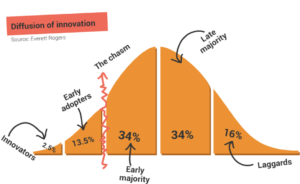A lot of people are saying that now is the time for innovation. I absolutely agree, but I would add that every time is a good time for innovation. After all, regardless of the industry and type of business, we should be innovative, and we often want to be, but are we really? And what about You? Are You planning to introduce some innovation right now? And if so, do know what and how to do it, hmmm?
 I assume you have some idea to make a change – could be transforming your internal processes, implement a new IT tool or maybe you want to introduce a new product to the market. No matter what is Your goal here the question is how to approach it, so that the project will be successful.
I assume you have some idea to make a change – could be transforming your internal processes, implement a new IT tool or maybe you want to introduce a new product to the market. No matter what is Your goal here the question is how to approach it, so that the project will be successful.
And here Everett Rogers’ theory of diffusion of innovation comes in handy. It can really help to understand this incredibly complex problem in quite a simple manner. And understanding it is really worth your attention if you want to innovate. And you want to innovate, right? So let’s get started…

First of all, think about what features does your innovation have, based on those dimensions:
- Relative benefits – what are the efficiency gains relative to the current procedures, tools etc.
- Compatibility – to what extent will the new idea/solution align with the existing systems
- Complexity – how complex the new solution is and therefore how difficult it is to learn to use it, and also what level of knowledge is needed to begin using it
- Potential for reinvention – will it be possible to use it for initially unintended purposes
- Testability – is it possible to test the innovation and to what extent
- Risks – what are the potential losses if the implementation/introduction would fail
- Observed effects – what can be seen when using the new system and how tangible are the results
All of these features interact with each other and they will influence whether we can effectively introduce an innovative change, in our company or into the market, or not!
Having a broad understanding of the nature of what we want to introduce, now it’s time to look at the process behind the adoption of Your new idea or tool.

There are 5 stages:
- Knowledge – a person has heard something about a change coming, but isn’t trying to get more information on it
- Persuasion – the innovation is nearly here and a person is actively seeking related information and additional details
- Decision – people are making initial assessments and making decisions on whether they will want to adopt it or reject it. This is the most critical moment in the whole process. Studies and analysis showed that 2 factors influence this decision from the individuals perspective – whether the decision to adopt is made freely and implemented voluntarily and who makes the decision.
- Implementation – a person is starting to use the innovation at various degrees, depending on the situation. During this stage the individual determines the usefulness of the innovation and may search for further information about it
- Confirmation – the individual makes a final decision to continue or not using the innovation. It has an individual impact but also it could be a confirmation on whether the group made the right decision
So far so good, but I left the most important and the most difficult part of any innovative project – the diffusion of innovation curve. It resembles a normal distribution and includes 5 categories of people, who react to novelty in a particular way. The most difficult task is reaching the 3rd group, because there is the tipping point and to achieve that you need to jump over “the chasm”. The law of diffusion of innovation states that after overcoming this obstacle your project can be considered a success!

Those 5 categories of people are as follows:
- Innovators (“enthusiasts”) (2,5%) – here you can find people who like novelty, taking risks, they tend to have a high status – sometimes financial sometimes social and because of that they’re not afraid to try out something new, even if it could fail. You don’t have to do much to get them on board
- Early adopters (“visionaries”) (13,5%) – they are open to new ideas but they a more cautious in adapting new ideas. They are very influential people in the organization or on the market. More encouragement and providing additional information is needed to convince them to try out new ideas, make changes or use new systems/tools
- Early majority (“pragmatists”) (34%) – the people in this group are focused on the utility of the new solution. They are focused what they will gain from it. This is the most important group, because once they are using the innovation that means you crossed the “chasm”. This is where You need to focus on the pragmatic outcomes of your idea or change you want to introduce
- Late majority (“conservatives”) (34%) – people in this category use the innovative product only because they have to. You need to provide a lot of support and encouragement for them to start convincing them to the change.
- Laggards (“skeptics”) (16%) – this group will be the last to accept and adopt the innovation, but having objections till the very end. They are people who adversely react to any change or a new thing and would like to things stay as they are. Trying to convince this group should be considered a waste of energy and resources should be focused on getting through to the other groups
I hope that now you know what do you need to do – think about what you’re planning, how to make it through the adoption process on the individual level and finally how to navigate through the innovation curve in the pursue of reaching the majority of potential customers or users.
About the author:
? https://www.linkedin.com/in/nowakrob/
? r.nowak@stowarzyszenieim.org



